#reseda luteola
Text
Yessss ... Reseda luteola grows in sandy, loamy soil!ñ
...
..don't ask. I'm a writer. 💀
#and cemeteries are also best on loamy soil#writer search history#lol#life of a writer#yellow dye#reseda luteola#weld#weld plant
1 note
·
View note
Photo






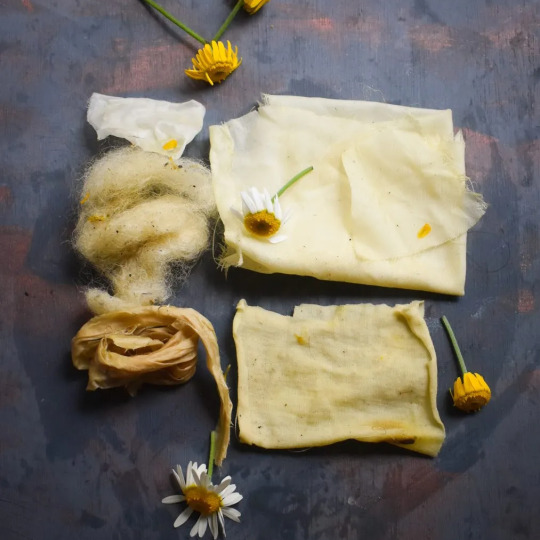


x x x x x x x x x
Natural Dyes used by the Elves and Humans Part One (by color)
Part of a series on fabric, textiles, and fashion throughout Arda
Other posts: Hairstyles among the Edain, Elven and Human Crowns, Noldorin fashion, Telerin fashion (contains other topics too) Vanyar fashion(contains other topics too)
I always love world building like this so please feel free to request topics! I also can’t cover all cultures in each post so feel free to prompt me others to cover!
Finally you can also always ask me to cover peoples or places through the lens of real world locations
Red, orange, yellow
Note: salt and tannic acid are the most common mordants. I can make a separate post on that though if there’s interest
The roots of Common madder and other madder species was used primarily by the Bëorians of Ladros as well as the humans East of the Ered Luin. The method was learned by elves and dwarves in and around the Ered Luin as the Bëorians moved West. It was the plant they used most commonly for dyes and produced the color for their ceremonial sashes among other things. It was used for wool and flax fabric
Alder bark is used by the Sindar both in and outside Doriath (especially in Mithrim) and by the Halidan to make both red and yellow dyes and thus orange dyes. It was used mostly for wool
Saffron was used by both humans and elves in Northeastern Beleriand and East of the Blue Mountains. It made a yellow dye that could be used for linen, flax and cotton fabrics
The pollen and flower of fennel was used for pale red dyes in Nevrast by the Sindar and in some parts of Ossiriand by the Green elves.
Roccella tinctoria, a lichen was used to create a red dye mainly found on rocks in Nevrast and was collected by the gray elves and Falathrim.
Dyer’s weed or Reseda luteola was used throughout Beleriand and to the East though most commonly by the Falathrim and the Green elves.
Hypericum perforatum (St. John’s wort) was found throughout Beleriand and to the East though was used primarily by the Hadorians to make yellow dyes for non woolen fabric
This is just a selection I put together while at work! As always please feel free to ask more! I love ethnobotany and similar topics about plants and stuff
78 notes
·
View notes
Text
09/19 Homework "A Cup of Flowers"
plants:
prunella vulgaris: this plant is known as the self-healing plant or the heal-all plant. this is an edible plant and is used in soups, and drinks, and mixed into other things to access its healing properties.
reseda luteola: also known as the Dyer's rocket. this plant is used to mix create a rich yellow dye and with a certain blue to sometimes make greens.
filago pyramidata: also known as broadleaf cottonrose. this is a European plant species that is in the sunflower family. it is typically found in more of the eastern hemisphere.
Attendance Prompt
"...language influences or even shapes perception and that without the word for a color, we see it as distinct." (35)
I believe this to be true because even in human nature when we don't understand something or "distinguish" it we tend to ignore it. I believe once you learn about something interesting it really sticks in your mind. Once I learned about the color periwinkle I never stopped talking about it for a couple of months. Same thing with the color sienna. Before I knew how it was spelled I associated it with Siena College so I always thought it was a green color. Turns out it is a nice brownish color that gives calming vibes.





2 notes
·
View notes
Text
Clothes sketches for my Lamb OC!
I'm struggling with putting Mina in clothes. Clothes are an important part of a character's design and can help visually show aspects of a character without it needing to be said. But when it comes to characters who don't really need clothes for thermoregulation it becomes a form a cultural and self expression. Which is dependent on the world the character is in. So many moving parts...
Initially I only drew the clothes and didn't include Mina's fleece. Then I realized the her fleece is still a part of her wardrobe even if she can't take it off normally.

1) The first design was inspired by Skyward Sword Zelda's ceremony / goddess dress. I changed the sleeves to make it more comfortable for someone covered in wool. It is very light and partially transparent. It was going to be Mina's sacrifical or priestess clothing.
2) This design is the same as the first but I removed the sleeves altogether. More comfortable.
3) A simple long vest or house coat for Mina. Something she would wear to keep her wool clean. The green color was inspired by Ratau's tunic. I researched natural cloth dyes and determined that Ratau, and Mina, could have access to the resources to make this color consistently.
For those who are interested, this green resembles Lincoln Green, a color produced from combining woad (Isatis tinctoria), a strong blue pigment, yellow weld (Reseda luteola) pigment or dyers' broom, Genista tinctoria. I use this green liberally when coloring.
The wraps on her legs, which I forgot to color, are inspired by show animal care. Apparently to keep a sheeps boot wool clean before a show, keepers cover their lower legs.
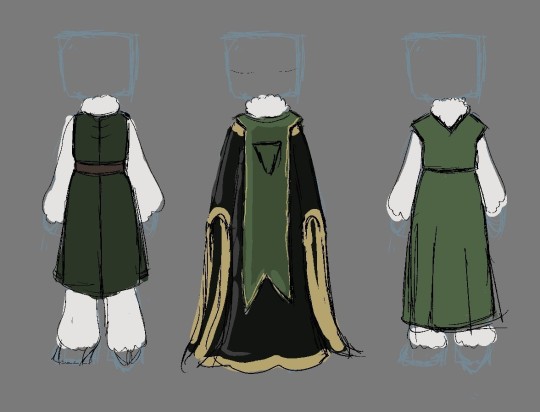
4) A thick green tunic inspired by Ratau's vest.
5) Ceremonial Vestments of silk with gold embroidered hems. Mina's own cult, not TOWW's, was going to feature green instead of red.
6) A simple green linen tunic.
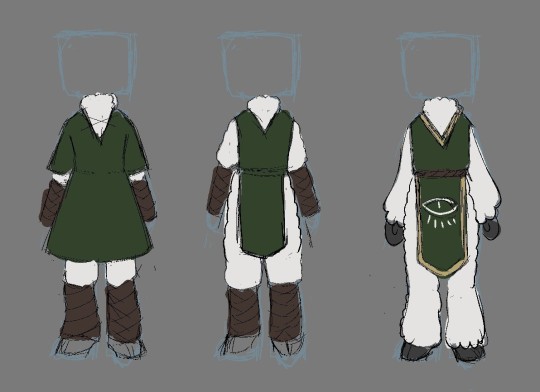
7) I was trying to figure out what Mina would wear while crusading. The brown leg wraps and green tunic would make her look like Link. Mistakes were made...
8) A green linen tabard with brown leg wraps. I wanted clothing with less material for Mina to wear.
9) A fancy green tabard with gold embroidery. Maybe something light to wear around the cult that marked Mina as the leader.
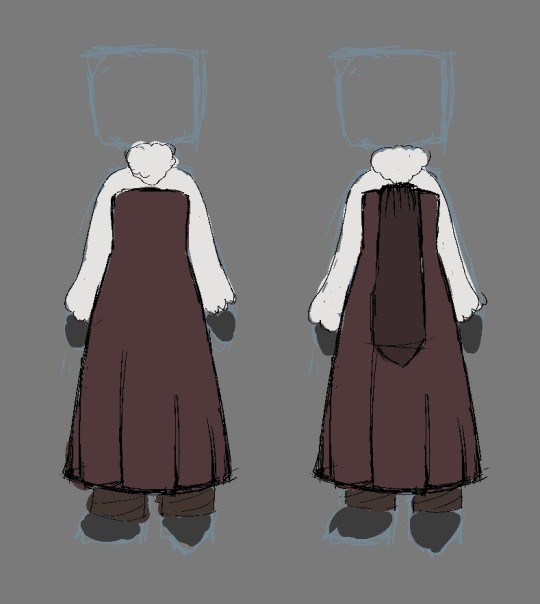
10) & 11) A simple red sarong like dress with leg wraps. No sleeves. I like these, I might make them shorter though.
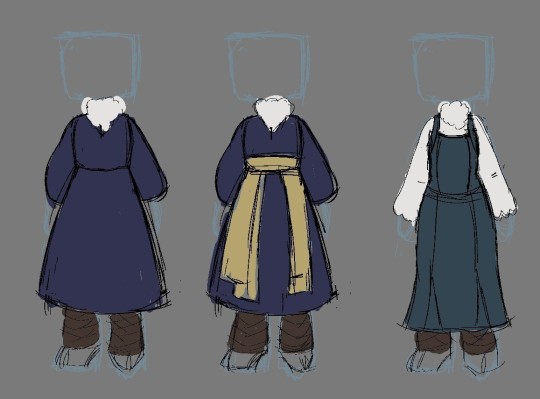
12) & 13) Purple linen dress with gold belt wrap. I wanted a design that was more witchy but I felt it didn't fit Mina. Purple would be a hard color to find and I felt the dress would be uncomfortable over her wool.
14) A heavy blue denim overall dress with leg wraps. Something for Mina to wear while cooking or working around the cult.

15) & 16) just practicing the canon! Follower robes.
17) Gold embroidered robes and a black wool vest denotes a high level follower. In my COTL playthroughs I give followers with really good traits special titles like Keeper and Deacon in addition to their names.

18) Tried putting mina in pants. Hated it.
19) A shepherd's Crook Scythe. Mina would use it as a catalyst for curse but it can double as a weapon in a pinch. It would also be a staff-of-office for Mina's position as TOWW's cult leader.
20) A corset belt with pouches. What would Mina keep in those?
21) A red crusade cloak with bell. One of my favorite designs I've come up with. I wanted something that screamed "I do Magic". I fell in love with slit sleeves. They look plain but elegant. I added the corset belt but with no bags.
22) A green "fleece of the glass canon" crusade cloak. I previously wanted to stick with the canon design for fleeces, a short cloak, but I really liked the design #21 and wanted to create derivatives of it. It's lined with red linen/wool.
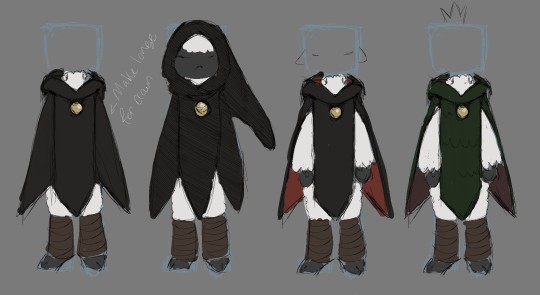
23), 24), & 25) Black Crown cloaks with bells. Mina would transform the Red Crown into a cloak to wear while crusading. The hood is very long and pointed to give it a magic-user look.
26) A "fleece of the glass canon" cloak that Mina would use as a template for her crown cloak.
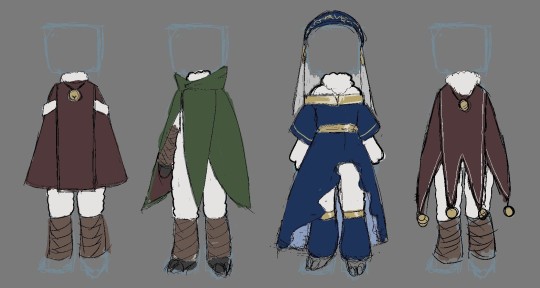
27) this cloak was inspired by Witch Hat Atelier. I didn't like it for Mina. For the woodland setting it felt too refined amd modern.
28) this cloak was inspired by Sypha Belnades' cloak from the Castlevania animated series. I like the look but that hood / collar makes absolutely no sense and I hate that.
29) this isn't an original design but something I saw on some Zelda fanart. I wanted to see how it would look on Mina. I like it. I added leg wraps. It initially had a dress underneath but I got rid of it. Too many layers.
30) I tried to incorporate some of my previous designs with the canon "fleece of the Lamb". The bells on the ends make it look like something a court jester would wear though. Also I don't think it would be a good idea to wear something that makes a lot of noise while crusading/ adventuring. Unless that's the plan. I imagine a very self assured lamb would wear something like this.
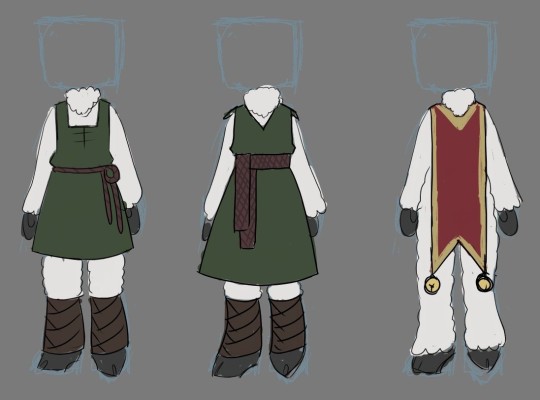
31) & 32) A simple linen pinafore with a braided cloth belt and leg wraps. The colors are based on Ratau's tunic. I feel like Mina would wear this before she started being a cult leader.
33) I don't know when Mina would wear this. It might go over ceremonial vestments or she wears it when visiting TOWW.
#cult of the lamb#cotl#my post#my art#character creation#character design#cotl character design#cotl oc#cult of the lamb oc#original character#long post
11 notes
·
View notes
Text
Growing and Harvesting Weld (Dyer's rocket)
Growing and Harvesting Weld (Dyer’s rocket)
This is a blog post on growing and harvesting weld. Weld is also known as Reseda Luteola or dyer’s rocket is an old ancient dye plant that produces a yellow color. Ancient as in early 1st century BC. It can range from dull to yellow-green. It is a biennial plant which means it’s has a two-year life span like woad. Here is a link on how to grow woad. To be honest I discovered a few matured…

View On WordPress
0 notes
Text
i want to grow some dyer plants in the apartment bc foraging isn't really accessible to me
but i cant figure out where i could put them without my cat reaching them (eco unearths every plant they can get their hands on its wild)
#my cat is a dog at heart#im thinking of growing#madder (rubia tinctorum)#woad (isatis tinctoria)#and maybe weld (reseda luteola)#maker's diary
4 notes
·
View notes
Photo



Reseda biondella (Reseda luteola L., Resedaceae)
7 notes
·
View notes
Photo

Samples of wool dyed with a range of plants including (clockwise from left to right): Walnut (Juglans regia), Weld (Reseda luteola), Madder (Rubia tinctorum) and Indigo (Indigofera tinctoria).
Read more about these natural dyes on our blog.
294 notes
·
View notes
Text
Viking Dyes
Colours from Plants
The Vikings used plant dyes to colour fabrics and wool yarn. Each time dye was used, the colours become weaker and weaker, making it possible to get different shades.
RED
Red dyes were made from the roots of the madder plant (Rubia tinctorum). Madder didn’t grow in Scandinavia. It was cultivated in other countries such as France and the dye was probably imported.
BLUE
The only Nordic plant that produces blue is woad (Isatis tinctoria).
GREEN
Textiles turn green if they are first dyed blue and then dyed yellow.
YELLOW
Almost any green plant can be used to dye fabrics yellow. Analyses of textile fragments show that weld (Reseda luteola), a common Scandinavian plant, was used to dye textiles yellow during the Viking period.
#Vikings#History#Thanks to Swedish History Museum#Thor#Loki#Historical dye#Thor and Loki AU Inspiration
2 notes
·
View notes
Photo

Reseda alba, growing wild on the hill above my school. Its cousin, Reseda luteola, is one of the most ancient yellow dyes. Learn more about our online course on natural dyes, at jointheflow.net #reseda #resedaalba #weld #naturaldye #plantdye #naturaldyeing #naturaldyeingworkshop #naturaldyersofinstagram #naturaldyestudio #naturaldyer #naturaldyes (at Áno Kypséli) https://www.instagram.com/p/B-EygczJQ5E/?igshid=1t141phjmdtqt
#reseda#resedaalba#weld#naturaldye#plantdye#naturaldyeing#naturaldyeingworkshop#naturaldyersofinstagram#naturaldyestudio#naturaldyer#naturaldyes
0 notes
Photo

Got seeds? A little over a week ago I harvested the tops of my weld plants (Reseda luteola) and put them in paper bags to dry. This way I can easily collect the seeds. Each plant produces a gazillion teeny tiny seeds (there are over 30 seeds on my finger in the bottom right). I had planned to harvest the rest of the plants in the following days, but life happened, as it does. Interestingly, the plants produced a whole bunch of new flower tops! Who knew you could "dead head" weld? Kinda cool. I'll wait to harvest until the bees have had their fill. The flowers are swarming with honey bees, while the bumble bees party over on the bee balm you kinda see behind the weld inside the fence. As a biennial, we should only be able to harvest these plants every other year, but you can fake them out by planting then early fall so they overwinter and think that the next spring is the 2nd year. I learned the hard way that they don't particularly like good soil. They seem to be happiest on the side of the road. My gravel driveway is the next best thing. #dyegarden #naturaldye #fiberartist #rughookersofinstagram https://ift.tt/2JAG3On
0 notes
Text
Expansion of Natural Dye Colour Gamut for Use by the Local Textile and Craft Industry- Juniper Publishers

Abstract
Natural dyes have been used since long back in various areas such as textiles, craftwork, food colouring and also as medicine. This work was based on expansion of the colour shade that can be obtained from natural dyes for use by the small scale users. The natural dye was extracted from three naturally available plants locally in Zimbabwe using the cold extraction under gravity method. An alcohol was used to extract the dye using a vacuum pump and left to dry. The extracted dye was then used to dye fabric strips using different metals as mordants. From the colour charts generated from the various dyeings it was shown that the shades can be extended for certain plants and in some cases they are not easy to expand. Application of the metal mordants at different concentrations was also found to have an effect on the hue of the dyed fabric strips. The results show that the natural dye from the Mukwa (Pterocarpus anglonesis) gave a wider range of shades as compared to the other two dyes.
Keywords: Natural Dye; Colour; Mordant; Synthetic; Textile
Go to
Introduction
Humans have used natural dyes for colouration thousands of years before 10,000 BC with the oldest examples being prehistoric cave paintings, which show the already-sophisticated use of carefully-graded colours [1]. All textile materials be they natural or synthetic they are dyed creating a better aesthetic value and in line with customer expectations. Anciently, the dyeing process to textile materials and other craft products was accomplished through use of colours of natural source, up until synthetic colours or dyes were invented and commercialized. The sources of these natural colours or dyes include insects, plan leaves, fruits and roots. But nowadays most of the colours used in commercial textile dyeing are synthetic colours [2]. Historically colours commonly derived from plants included yellows, largely extracted from weld (Reseda Luteola), but also found in other plant species like quercitin and persian berries. Madder (Rubia tinctorum) is known to be the most important source of the red dye alizarin, though some other reds were also extracted from insects like cochineal and kermes [2]. The colour black was obtained mainly from logwood, although it could also be made from mixing dyes of other colours [3].
As of late there has been a growth and interest in the use of natural dyes in textile colouration. This is to some extent, attributed to the strict environmental standards enacted by many countries in response to the toxic and allergic reactions associated with synthetic dyes [4]. Natural dyes are more environmentally friendly than synthetic dyes and can exhibit better biodegradability and generally have a higher compatibility with the environment [5-6]. Currently the global demand for natural dyes world over is about 10,000 tonnes, which is equivalent to 1% of the world synthetic dyes consumption in the whole world [7].
Within the food industry natural dyes can also be used as colourants though they have some disadvantages compared with synthetic colourants as they are more expensive and less stable, but with the advent of a well-informed consumer who is very particular about their health natural colourants or pigments are gaining attention as they are considered harmless or even healthy [8]. In some countries like the United States and the European Union they have restricted the use of synthetic colourants as food additives thereby increasing the uptake of natural colourants in the food industry as consumers require foods to be as natural as possible [9].
In their research in rural part of south eastern Zimbabwe [10] identified the use of birchemia discolor in colouring the art products done by the rural folk. The bark of birchemia discolor may be collected and also branches or even roots, and then boiled in water to produce dye used to colour the craft products [10]. The fibre to be dyed is then soaked in this solution, until the desired purple colour is achieved, and then hung in open air to dry. [11] states that due to the economic hardships that have befallen most families in rural Zimbabwe accompanied by severe droughts, families have had to look for alternative sources of income in order for them to survive such as harvesting, processing, and sale of craft products. The increase in tourism activities in post independent Zimbabwe has also contributed to growth in demand for curios and craft items, including those made from bark [12].
Natural dyes are less toxic, less polluting, less hazardous as compared to synthetics, non-carcinogenic and non-poisonous. They also do produce harmonizing colours which are gentle, soft, subtle and create a restful effect. Above all they are environmentally friendly and promote the issue of sustainable in dyeing principles. Extensive use of natural dyes as sources of colourants requires one to do multiple dyeing cycles in order to produce deeper shades and also the addition of a suitable mordant for the achievement of different colour depths required. The problem of a limited number of shades has affected the appreciation of natural dyes by many and also their unavailability for large scale processing. On the crafts produced the local Zimbabwean communities there is evidence of use of the natural colours [10]. These brilliant decorations provide a unique selling point as it is a combination of mastering the colours and the art of decorations which can make one sell their products for a good return. These communities depend on the income they get from the sale of their artifacts therefore empowering them with the knowledge on how to improve their colour ranges is beneficial. Providing an extension of the shade gamut obtained from various natural colours extracted locally in Zimbabwe is important as it gives the local crafts people a wider selection of use for their dyeing activities. Colour on its own is a very important part as it affects the aesthetic appeal of any textile product. The ability to provide a wide range of colours within the natural colours is therefore important as it brings more variety in design.
In areas where synthetic dyes, and other processing chemicals or additives are imported resulting in higher costs to dye, natural dyes can offer an attractive alternative [13]. Zimbabwe has abundant natural forest resources which can be a source of quite a number of these natural dyes. As of late there has been more push worldwide to promote sustainable practices in the way live. Within the field of textile dyeing one such method is through use of natural colouring matter as it is not harmful to the environment as compared to synthetics. This study therefore seeks to improve on some of the shortcomings which are prevalent with use of natural dyes as a colouring matter, with an effort of empowering the local craft industry who earn lives through this trade. Natural dyes have been used in different areas for a long time though on a rather small scale therefore production of a colour chart and recipe guides to achieve different shades can be also of importance to various industries. Commercialization of the locally found natural dyes in Zimbabwe is very possible and can be improved if the shade ranges are also standardised.
Overview of natural dyes
The colours obtained from natural plants are always a varying parameter as this is determined by the impurities peculiar to that plant material used. This is one of the reasons they have not been popular by dyers at large scale who would want to standardise their colours. This is what made these natural dyes lose out on the market to the synthetic dyes though they are appealing to today's craftsmen as they seek to capitalize on this uniqueness in natural dyes. One of the most successful projects on natural dyes is the Dogal Boya Arastirma veGelistirme Projesi (DOBAG) of Anatolia in Turkey. In this project natural dyes have been used to print fine Turkish carpet prints that are highly valued and attractive [14]. In India there is also a natural dye project Aranya supported by Tata Tea which helps in employment of the physically handicapped and also family members of the employees of Tata Tea [14]. Most natural dyes give a shade of brown or beige when used as a fabric dye. Others produce strong brilliant colours but they have poor fastness properties for both light and washing [15].
Other uses of natural dyes and their sources
Natural dyes have been used for many centuries as hair and face colourants. Thousands of years ago it was common practice for Indians to tint their faces yellow with saffron and to dye their feet red with henna. In similar times Chinese women used vegetable extracts to dye their feet, cheeks and tips of their tongues. Several dye yielding plants can also contain substances with pharmaceutical properties. Modified aniline can be used as an important drug and as well as a dye Table 1. Traditionally the Msasa (Brachystegia spiciformis) tree which produces a red dye has been used to cure some ailments like dysentery and malaria [16]. Fruits from the Marula (Sclerocarya birrea) produce a natural red dye and they can also be used as food source as well as brewing of beer known as mukumbi locally in Zimbabwe. Natural dyes can also be used in the food industry and the medicine industry [1,17]. Within the food industry their application faces challenges as they exhibit chemical instability, poor tinctorial power and limited number of shades available for example beetroot can produce a deep red colour but the extracted pigment is unstable [17].
Mordanting process
A mordant is a substance which serves to fix the colour on the textile substrate. From a single coloured dyestuff various shades can be obtained by simply varying the mordant used [18]. Therefore, the addition of a mordant can change the pH of the dyebath and hence the colour and thus help in the absorption of the colour to the fabric. Mordants are generally composed of metallic oxides or earth oxides. Of the earthly oxides the most generally used is alumina either in common state of alum or in triacetate of alum [12]. There are three ways of applying a mordant to a fabric and these are, postmordanting, simultaneous mordanting and premordanting. The choice of which mordanting process to use depends on the nature of the natural dye, nature of fibre to be dyed, type of mordant to be used and quantity and quality of hue required (Gupta et al.2001). In premordanting there is pre-treatment of the fabric with other chemical assistants and in postmordanting of the fabric compounds like chitosan and other metal salts are used to help in improving the fastness of the dye. It should be noted that it is very possible to dye without a mordant for example natural dye from indigo plant does not need mordanting but the use of a mordant usually results in a better, brighter and a more permanent colour.
Go to
Methodology
Extraction of the dye
The process of extraction of the colour component from source natural dye material is an important step for dyeing any textile substrate to maximize the colour yield. According to [19] standardization of the extraction process and improving extraction variables result in better colour yield and reduced extraction and dyeing costs. In this work the plant bark was used for the three tree plants used and these were sourced from Chivi district in Masvingo province in Zimbabwe. The bark was allowed to dry within a period of a week, avoiding direct sunlight as this could have an effect on the dye structure. After drying the barks it was then ground into a fine powder using a pestle and mortar as means to facilitate the extraction process by increasing surface area of the source material. The dye was extracted using the cold extraction under gravity method. The dye was separated from the solvent using a rotary extractor which evaporates the solvent under vacuum and then allowed to dry for a period of three hours.
Pretreatment of the fabricw
Pre-bleached 100% cotton fabric pieces were put in a beaker and brought to boil whilst stirring. This process of premordanting was carried out for a period of 60 minutes at boil and the fabrics pieces were allowed to cool and soak overnight. The amount of mordant was varied from beaker A1 to A4 as shown in Table 2. The fabrics pieces were then washed with warm water after the pre-mordanting process before they were taken for dyeing.
Dyeing process
Three different methods were employed for the dyeing process in an effort to achieve different results. The dyeing was carried in the temperature range 70oC-800C and maintained in that range, as high temperatures might destroy dye structure.
a. Pre-mordanting: The pre-mordanted fabrics were dyed using the three different dyes extracted from the three plants. Four beakers labeled A1-A4 were used for the dyeing process for each dyestuff extracted from the plants. Predissolved extracted dyestuff was added into each beaker and the mount was 5ml (0.5%owf). The fabrics pieces were then added to the dye bath and heated to reach boiling point for 15 minutes before simmering at a dyeing temperature in the range of 70°C-80°C for 45 minutes after which the fabric is washed using soap and allowed to dry.
b. Dye concentration-In an effort to expand the colour gamut the dyeing process was repeated using the same amount of mordant. The amount of dye used was 1%owf, 1.5%owf and 2.0%owf
c. Non mordanted-This dyeing process was done as a control and to realise the effect of the mordant on the dyed material. The liquor ratio was maintained the same, only that the fabrics were not pretreated they were simply washed with warm tap water and dyed at the same concentration as those pretreated.
Go to
Results
Extracted dye
Amongst the three sources of the dyes the Vitax Payos (VP) extract had the lowest percentage yield as shown in Table 3. The colour of the dye in solution is yellow but when left to stand for a few hours it turns into a muddy brown colour. The vitax payos dye does not completely dissolve in water and thus should be applied with an additive in the dye bath. But for the sake of uniformity the dye bath additives were not used so as so as to control the results for all the three dyes extracted. The other two dye extracts namely from Pterocarpus Anglonesis (PA) and Parinari Curatellifolia (PC) showed similar colours on observation as they exhibited a reddish colour
Spectroscopy
The results in Figure 1 show that the three dyes extracted for the natural plants absorb at different peaks as shown by their absorption spectral lines. The observed colour do not tell us much about the chemical structure and wavelength of maximum absorption of the dye. The two dyes PC and PA are similar in colour on observation but their absorption spectral lines are different meaning to say that they have different 540nm to 640nm suggesting the presence of colour red whilst VP has a peak absorbance at 460nm a range in the brown shades.
Dyeing results
a. Parinari curatellifolia: The fabric readily picks up a reddish colour as soon as it is immersed in the dyebath but later turn turns to a greenish colour and then a precipitate when iron chloride (FeCI3) is used to pre-treat the fabric. This shows the presence of Fe3+ ions as the fabric starts to turn to a brown colour. Continuously increasing the mordant quantity also affects the colour, especially with FeCI3 as the colour becomes a dark brown. Aluminium chloride (AlCl3) showed little variation even when the mordant used was increased though the colours turned to the pink range. On the fabric piece dyed without a mordant the dye easily bleeds on washing with soap. The colour chart of the dye is shown in Figure 2.
b. Pterocarpus anglonesis: The dye readily dissolves in water thereby it is readily picked up by the fabric strip as soon as it is immersed in the dyebath. This dye produced the highest number of shades depending with the mordant used refer to the colour chart Figure 3. Using potassium dichromate (K2Cr2O7) at higher concentrations resulted in more reddish shades. Aluminium chloride (AlCl3) produced the lighter shades similar to when the fabric is dyed without the mordant.
c. Vitax payos- On adding the fabric in the dye bath, it slowly picks up a brownish colour and when left to stand a greenish precipitate is formed. The shades obtained from the dyed samples were not level when the mordant iron chloride was used. The colour chart for this dye was not as wide as compared to those of the other two dyes extracted. Using aluminium chloride (AICI3) and potassium dichromate (K2Cr2O7) did not produce any noticeable result though high concentration of dye and high concentration of mordant were both tried. Iron chloride produced slightly different results when the quantity used to pre-treat the fabric was altered but the shades were not very different as shown in colour chart Figure 4.
Go to
Discussion
Shade expansion
Pterocarpus anglonesis (Mukwa) natural dye showed that a higher number of shades are obtainable when the dyeing parameters like mordant quantity, mordant method used, dyeing time and concentration of dye used were varied. To expand the colour shades obtained from natural dyes more intense primary colours can be used, for example red, blue and green or yellow are used. The more intense colours may not be in abundance locally but plants that can give a closer shade can be found. Indigo dye yielding in plants can also be cultivated thereby giving us the more intense blue colour. The major advantage is using indigo is that it does not require any mordant for its application. Expanding the colour shade will help the application of natural dyes in other non textile industries like food, drugs and cosmetics. The colours shown ion the colour charts exhibit the fact that applying slight variations on natural dyes one can achieve a range of colours even at the smallest scale.
Extraction methods
At a low scale the extraction of natural dyes is done through boiling of the plant material so that the dye can be obtained. This method has problems in that some of the dye may not be extracted and also the higher temperatures used may be too harsh for the dye resulting in dye structure being destroyed [18]. Ultrasonic energy is now being used to extract the natural dyes as it saves on time and chemicals and does not affect the dye structure but its major hindrance is on the costs attached to this method of extraction [20]. The difference in method of extraction also affects the shade achieved from each natural dye. The shade also is affected by the plant characteristics and the climatic conditions under which it grows.
Auxiliaries to dye bath
When the dye from vitax payos was used there was poor levelness of shade. The problem could have been reduced or totally eliminated by addition of sodium chloride or sodium sulphate. These are inorganic salts which act as leveling agents by retarding the rate dyeing and giving a more even shade. The pH of the dyebath also needs to be carefully controlled by adding sodium carbonate or soda ash. All these auxiliaries help in determining the shade. Natural dyes differ in their percentages of chemicals especially tannins which can also act as mordants, therefore pH needs to be consistently monitored, so that all the dyeing are carried under the same levels of pH.
Mordanting process
For the colour charts obtained from the three (3) natural dyes, only one method of mordanting was used, that is premordanting method [21]. Since there other methods through which the mordant can be introduced to the textile fibre to aid take up of the dye, they also result in different shades. Only three mordants where used to expand the colour charts with iron chloride and potassium dichromate giving marked results. The presence of Fe3+ and Cr3+ cations show different shades for the same dye used as premordanting agents. The cations in these mordants also have an effect on the shades which can be obtained. It should also be noted that iron can be used as an after dye application as it helps to warm the colours as shown when it was applied to the other samples.
Go to
Conclusion
The work has highlighted that it is possible to produce wider ranges of shades for any particular dye by varying the dyeing parameters. Despite the limitations of natural dyes one may say that the future may be extremely bright if one takes into account several strategies to go natural. These natural dyes have a place in today's world if they are processed and marketed in the best way to enlighten the users about benefits of using these dyes. Research work to find other natural plants which give the highest yield per given colour is also very important especially locally in Zimbabwe where there is a wider variety of species in abundance. Natural dyes cannot be thought of as substitute for synthetic dyes but they can create a market of their own that can turn out to be highly commercial. Imparting correct knowledge to the users and the market of these dyes is a stepping stone in the process of finding a correct synergy between extraction and the use of the dyes. Some cultivation techniques for certain staple vegetation colouring matter must be researched in order to achieve an acceptable gamut and fastness properties. Natural dye sources are not only limited to plants but other natural sources like insects. This development of a wider range of colours can be of great benefit to the communities where the villagers survive on small handicraft work as this will add more aesthetic value to their wares.
To know more about Journal of Fashion Technology-https://juniperpublishers.com/ctftte/index.php
To know more about open access journals Publishers click on Juniper Publishers
#Juniper Publishers#Juniper Publishers Group#fashion Technology#Textile Engineering#Fashion Technology Trends
0 notes
Link
ANCONA – Dalla Nigeria martoriata dal terrorismo all’Oscar Green. La favola di Jeffery Eromosele Osoiwanlan continua con l’ambito riconoscimento per i giovani impegnati in agricoltura conferito ogni anno dalla Coldiretti. Jeffery dopo aver vinto la fase regionale nella categoria “Noi per il sociale” è arrivato alla nomination nazionale e questa mattina è stato premiato a Villa d’Este di Cernobbio, sul lago di Como, nel corso del XVII° Forum internazionale dell’agricoltura e dell’alimentazione, organizzato dalla Coldiretti.
Tanti giovani in un periodo in cui il talento italiano riscopre l’agricoltura dando valore alla tradizione ma senza dimenticare l’innovazione, l’etica e le buone pratiche.
“Siamo orgogliosi di questa vittoria, perché Jeffery e la sua storia raccontano quanto la campagna sia sopratutto una questione di integrazione e di responsabilità sociale – ha detto Maria Letizia Gardoni, delegata nazionale dei Giovani e presidente di Coldiretti Marche che ha anche premiato Jeffery – Che possa essere di esempio per chiunque abbia la volontà di accogliere e di dare possibilità di riscatto”.
Tra i 18 finalisti nazionali, dalle Marche, c’era anche Sandra Quarantini. Biologa molecolare, con la sua Color Off a Belvedere Ostrense, realizza colori naturali e anti allergia da piante tintoree, servendo tessitori, sarti e creativi in un mercato che vede molta richiesta di tessuti privi di coloranti chimici, soprattutto nel nord europa. La Quarantini nei giorni scorsi era stata anche premiata dal Copa, l’associazione delle organizzazioni agricole e cooperative dell’Ue che rappresenta gli interessi di oltre 23 milioni di agricoltori europei: secondo posto, unica tra le italiane presenti tra i finalisti, per l’innovazione in agricoltura.
“Ogni anno le giovani imprese ci stupiscono per quello che riescono a fare e creare – il commento di Alba Alessandri, delegata regionale di Giovani Impresa Coldiretti – Siamo veri imprenditori 4.0: dalle fattorie didattiche che recuperano razze in via di estinzione a chi fa colori naturali, come i nostri due marchigiani, noi raccontiamo una storia, un paesaggio, una distintività di prodotto e un patrimonio di biodiversità. Per essere sempre più competitivi e attrattivi dobbiamo essere necessariamente aiutati nell’accesso al credito e alla terra di modo da poter creare progetti di lungo periodo”.
E quella di Jeffery è proprio una bella storia di riscatto e di integrazione. Dopo aver lasciato il suo Paese natale, il giovane ha incontrato nelle Marche, a Montecarotto, la famiglia Gasparini, molto attiva nel sociale e proprietaria di un vecchio allevamento di cani dismesso. Aiutato dai Gasparini Jeffery ha restaurato lo storico casale ed è diventato imprenditore agricolo aprendo l’azienda Fattoria di Campagna. Oggi alleva centinaia di animali di razze e specie a rischio di estinzione provenienti da tutto il mondo, con laboratori dedicati ai più piccoli ma anche iniziative per gli adulti, dal bird watching alla tartufaia e ai percorsi olfattivi.
Le nomination marchigiane
COLORI NATURALI ANTI ALLERGIE – Sandra Quarantini – Belvedere Ostrense
Una start up del colore naturale in risposta ai problemi causati dai coloranti sintetici, all’inquinamento e alle allergie. E’ l’idea di Sandra Quarantini, biologa molecolare che dopo aver approfondito i suoi studi in America e in Turchia è ritornata nelle Marche dove ora coltiva piante tintorie nel rispetto della sostenibilità ambientale, nelle colline di Belvedere Ostrense. Nel suo laboratorio estrae tinture, offre servizio di tintura al naturale, studia ricette di colore su misura e organizza workshop per farle conoscere a tutti. Il colore principale di Sandra è il giallo che ricava dalla coltivazione di Reseda Luteola che in questi terreni rende esattamente il doppio in termine di efficacia del pigmento, rispetto ad altre aree in cui viene coltivata.
Dalla coltivazione all’essiccazione e fino al processo di bollitura e di estrazione del pigmento pensa a tutto Sandra. Ma non per una piccola nicchia di consumatori. Sono molti infatti – riferisce la Coldiretti – ad avvicinarsi al mondo del prodotto di qualità ed ecologico, dai tessitori ai sarti, dai creativi fino a tanti privati che vogliono tingere i corredini dei neonati, oltre a maglie e stole in canapa. Sandra parte dal giallo che di suo consente almeno altre 5 o 6 varianti che arrivano fino al verde ma la gamma di colori delle erbe tintorie vanno dal blu del Guado al rosso della Robbia. Sandra ha un altro sogno nel cassetto: utilizzare la reseda per un prodotto cosmetico, grazie alla sua potente capacità di protezione dai raggi Uva.
SFUGGE A TERRORISTI PER L’ARCA DI NOE’ – Jeffery Eromosele Osoiwanlan – Montecarotto
Questa è la storia di Jeffery, un rifugiato politico molto speciale che sfugge al terrorismo e alla povertà nel suo paese, la Nigeria e crea una vera e propria arca di Noè. Jeffery oggi è uno splendido esempio di integrazione ben riuscita, dopo aver lasciato il suo paese insanguinato dai terroristi di Boko Haram, nel 2015 arriva nelle Marche dove incontra la famiglia Gasparini, molto attiva nel sociale e proprietaria di un vecchio allevamento di cani dismesso. Enrico Gasparini e la moglie Lucia in lui vedono una luce, le sue argomentazioni non sono mai formali e superficiali e decidono di dargli un tetto.
Dal giorno dopo Jeffery è un uragano in piena, il machete per disboscare, il legno per costruire casette, e poi recinzioni, giardini e gli animali. Vuole che quel terreno diventi un’arca di Noè con tutti gli animali della tradizione contadina ma anche nuovi animaletti simpatici per i bambini. Nella Fattoria di Jeffery, infatti, convivono libere e in armonia centinaia di razze e capita di vedersi passare accanto un simpatico asinello vicino a un Emù, sorta di piccolo struzzo, mentre a pochi metri di distanza si muovono cigni e oche, cani e gatti. Ma ci sono tantissime anche la razze di galline che fanno uova colorate, dalla Padovana nera alla Moroseta, così come le anatre che vanno da quelle mute alle mallard, dalle mandarine alle germane, taglie grandi piccole e corritrici indiane. Jeffery vuole realizzare il sogno della famiglia Gasperini e ci riesce con una forza d’animo incredibile.
È un sentimento autentico quello di Jeffery che alimenta ogni sua azione, vuole che attraverso la bellezza del mondo contadino – spiega la Coldiretti – si possa costruire, giorno dopo giorno speranza per tutti e allora piano piano restaura lo storico casale e diventa imprenditore agricolo aprendo la sua azienda dove oggi alleva centinaia di animali di razze e specie a rischio di estinzione provenienti da tutto il mondo, fa continui laboratori dedicati ai più piccoli ma anche attività per i più grandi dal bird watching alla tartufaia ai percorsi olfattivi.
0 notes
Photo

Reseda luteola, commonly known as Weld, is a biennial or perennial herb. This grassland plant has great, tall spires of yellow green flowers. . It has been used since the Roman times as a source of natural yellow dye. Germany and France still process this plant into extracts and pigments on a large scale. . #faceinplant #plantoftheday #plantsofinstagram #plants #grass #grassland #yellow #dye #yellowdye #roman #france #germany #edenproject #eden #reseda #weld #herb #nofilter #spire #botanical #plantphotography #plant #plant (at Eden Project) https://www.instagram.com/p/BnWlwL3FRzM/?utm_source=ig_tumblr_share&igshid=l0pxmi60p4pq
#faceinplant#plantoftheday#plantsofinstagram#plants#grass#grassland#yellow#dye#yellowdye#roman#france#germany#edenproject#eden#reseda#weld#herb#nofilter#spire#botanical#plantphotography#plant
0 notes
Text
Word of the day for May 14, 2018
reseda , n : (botany) Any of various plants of the genus Reseda, having small, pale grayish green flowers such as dyer’s rocket (Reseda luteola) and mignonette (Reseda odorata). (botany, horticulture, specifically) Mignonette (Reseda odorata). A pale greyish-green colour like the flowers of a reseda plant; mignonette. reseda adj Having a pale greyish-green colour like […]
from Word of the day for May 14, 2018
0 notes